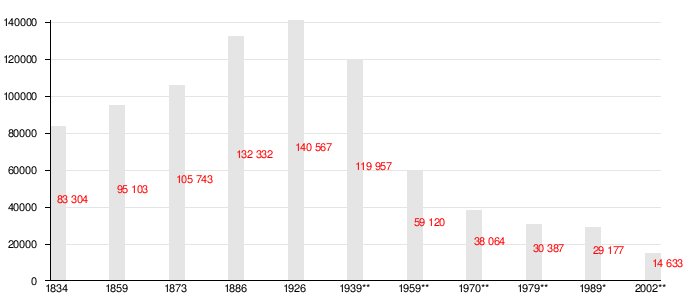Tver Karelians
| Total population | |||
|---|---|---|---|
| 23 000 - 100 000 | |||
| Regions with significant populations | |||
|
|||
| Languages | |||
| Religion | |||
Tver Karelians (karelsk. tverin karielazet, the name of the Karelian city of Tver) are Karelian people living in the Tver, Leningrad, and Moscow regions. They speak the dialect of the Tver Karelian language, which did not borrow from other Baltic-Finnish languages due to centuries of isolation. According to the National Population Census, the population of Tver Karelians is 14,633 persons. Out of that population, only 25 people indicated that they spoke only the Karelian language.
Contents |
History and origins
The question of origin of the Tver Karelian so far remains open. Today, there are two judgments.
One of them, Tver Karelians whose home was Olonets region, appeared on the Tver land in resettlement, which began on various estimates in XV-XVI centuries became, however, only after the massive defeat of Russia in the war with Sweden and the conclusion in 1617 Stolbovo. According to the results of Sweden withdrew Korelsky county and Ingria. The peak of migration were 1640-1660's. The mass exodus was triggered by the actions of Sweden to the new citizens who, in particular, forcefully translated from Orthodoxy to Protestantism. From these ideological oppression Karels, many tens of thousands, was asked to hand same faith Tsar Alexei Mikhailovich. It is estimated to 1670 on land Bezhetsk top, emptied by famine and epidemics during the troubled times of 25-30 thousand people were resettled.
Some researchers on the basis of a number of common characteristics and features of the Tver Karelian also ranked relatively small sub-ethnic groups and Tikhvin Valdai Karels formed simultaneously and in similar circumstances.
According to the census of 1926 in the Kalinin region Tver Karelian there were 140 567 people, including more than 95% owned Karelian language.
In the 1937-1939 year in the Kalinin region, then there Karelian National District with its center in Likhoslavl. Since 1997, operates national-cultural autonomy Tver Karelian.
The rapid decrease in the number of Tver Karelian, which found a map in the official statistics has its origin in the extremely low national self-esteem that was inherent in them from the middle of the XX century. The younger generation of that time, the bulk of being atheists, reluctantly taught their mother tongue and listened to "grandfather of custom" and "Babkin tradition." Also, because Karelia is a primarily rural dwellers, farmers, during the mass migration to urban areas (characteristic for almost the entire population of the Soviet Union from 1950.), for which the concept of "Karelia" and "an inhabitant of the wilderness," merged into one. So often the question: "Are not you Russian?" Followed the confused response: "No reason, I'm Russian!". In addition it should be noted that during the Russo-Finnish War, 1939-40s., To give legal form the ongoing military operations in the army, "liberating" the Soviet government sought to incorporate as many as possible Karels, many of whom For obvious reasons, strongly stremilist to avoid involvement in the fighting, in particular, rewriting its origin [source not given 82 days].
Dynamics of the number of Tver Karelian

** in the Tver region
Language
In contrast to other languages and dialects, Karelian language is preserved in the Tver most archaic form, which is probably the closest to a common proto-language Karels. It is believed that the formation of the vocabulary of Tver dialect was influenced by borrowing from the language of the medieval egonskoy villages, are now completely disappeared. Reliable information about the origin of writing in the Tver Karelian is not available in the XIX century, it already existed on the basis of the Cyrillic alphabet in 1930 was introduced on the basis of the Latin alphabet, which replaced the then vnovsostavlennoy Cyrillic.